I went out yesterday to photograph some California Hedge Nettle (Stachys bullata) on the slope above the gardens. The purple flower spikes are looking lovely massed together. I stopped alongside one plant for a closer look at the flowers, and made a rather fascinating discovery.
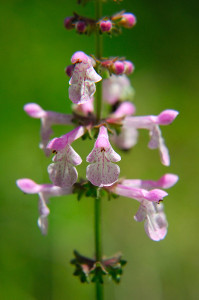
California Hedge Nettle (Stachys bullata). There's a surprise lurking on the far side of this plant...
When I pulled my eye away from the view-finder, on the far side of the plant, I noticed a bee dangling in a rather strange position. It was very difficult getting in front of the bee, because of some brush and other flowers I was trying not to squash under my feet. I managed to crane my neck around the plant just enough to see that a European honey bee (Apis mellifera), perhaps even one of my neighbor’s bees, was being dined upon by a spider that had it firmly in its grasp!
Every time I’d scrabble around to the other side of the plant, the spider would turn away from me, not willing to let me see (or potentially steal) her prize. Who can blame her, this is quite a catch! I struggled to get a photograph where I could see the spider clearly enough to actually identify it.
The crimson lateral streaks on the abdomen (just barely seen in the photograph below), and overall pale coloration, identify this spider as a female Misumena vatia, also known as the Goldenrod Crab Spider or Flower Crab Spider. This is a rather ubiquitous species that is holarctic in distribution, and is commonly found amidst sprays of goldenrod flowers in the fall.
Well, there’s no goldenrod (yet) blooming in my garden, but this spider seemed quite at home within the flowers of the California Hedge Nettle. This is the largest flower-spider species in North America. A predator that lurks among the flowers in your garden, preying on your garden pollinators. However, before you get too upset, it is a rather remarkable species.
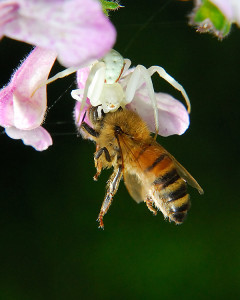
Apis mellifera being devoured by Misumena vatia (click image to enlarge...really...you should see this full size)
Misumena vatia is a chameleon. This spider can change color to better camouflage itself against the flowers where it lurks!
The Goldenrod Crab Spider changes colors between yellow, white, and pale green. It changes color by secreting liquid yellow pigments (kynurenine and 3-hydroxykynurenine) into the outer cell layers of its body when in its yellow form. If the spider lurks on a white flower the yellow pigment is transferred to lower tissue layers beneath the glands containing white guanine so the white color becomes more visible. If the spider spends an extended period on a white based flower, it will eventually excrete the yellow pigment. Changing from yellow to white takes approximately 6 days. It doesn’t really come through in the photographs, but this spider was more pale green than white. Changing back from white to yellow though takes longer, between 10-25 days, because once excreted, the spider needs to re-synthesize the yellow pigments before it can employ them to change colors.
How amazing is that?

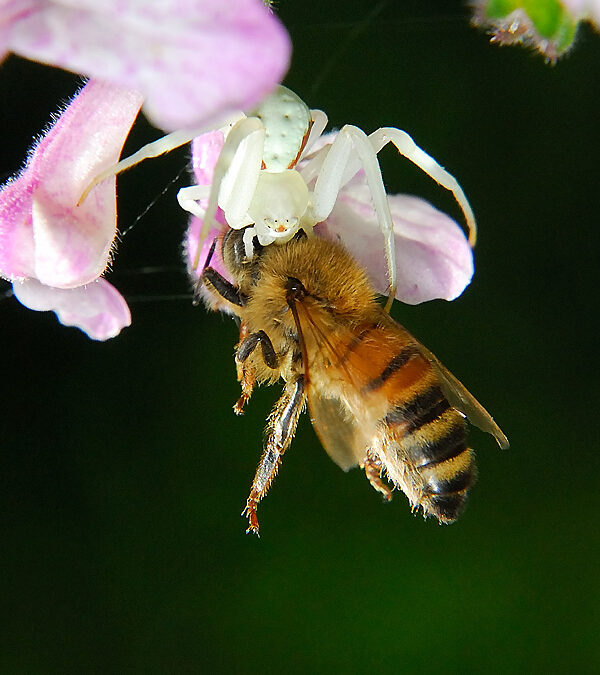
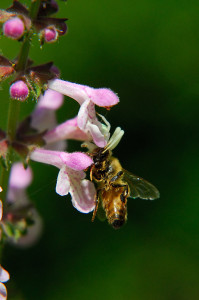
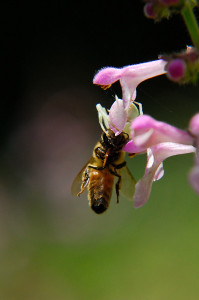







My Lord, you should photograph for National Geographic!!
Thanks 😛 Although if you saw how many shots I had to take just to get these few, you’d laugh!
How amazing is that! Now do you shoot with a macro lens to get these amazing close ups?
.-= Dog Island Farm´s last blog ..Wednesday’s Harvest =-.
Isn’t it amazing? I had no idea we had color-changing spiders in the garden.
I’m just using my 18-70mm lens, but with a +4 Macro filter.
Very interesting spider!
.-= Sheila´s last blog ..Glowing Foliage =-.
You just never know what you might find if you look VeRy closely…good eye! I love your photos and interesting info.
.-= Amy/GoAway, I’m Gardening!´s last blog ..Gardening Is A Lot of Things =-.
Isn’t it amazing the way nature’s camouflage systems work?! Beautiful photos!
.-= A Deacon’s Wife´s last blog ..Toil =-.
What a wonderful picture. It took me a while to see the spider in the enlarged picture – white not being the colour I was looking for!
Presumably the spider was quick to inject venom as I would not have thought a bee was easy prey.
.-= easygardener´s last blog ..The perfect garden =-.
We have them too. I posted Waiting … for Lunch, way back when. A flaming yellow beauty on a deep blue Cape Forget-Me-Not. Makes me wonder what colours bees see?
.-= Elephant’s Eye´s last blog ..My life, in oil-spills and shipwrecks =-.
I found your post Diana, by rummaging around your Birds & Wildlife page. Yours was a glorious yellow color. I haven’t yet seen one that color here, but now I know what to look for, I’ll keep a watch out.
How interesting to learn more about them. I didn’t know they changed color. The first time I learned what they were was last summer when I noticed one in a picture. My oldest daughter will find this fascinating. Too bad they eat the good insects.
.-= Catherine´s last blog ..Now I’m really getting excited! =-.
Love the pictures! Now I feel the need to buy a book on backyard insects. (and birds for that matter) I’ve seen some amazing spiders among my plants and never knew all of those interesting facts about them. Thanks for sharing!
.-= Jennifer´s last blog ..If you plant it then you should’a put a ring around it…. =-.
Great catch, for you and the spider. Outstanding photos.
Wish I could have ID-ed mine but after looking at a couple hundred photos at bugguide.net I had to give up or go bonkers.
Gruesome? wait till you find some Ambush bugs.
.-= wiseace´s last blog ..How Now Spider Cow =-.
Really fantastic photos~I was charmed by the stachys and then captivated (!) by the bee and spider. gail
.-= gail´s last blog ..My First Real English Garden =-.
How absolutely fascinating! I almost feel sorry for the bee 🙁
.-= Noelle / azplantlady´s last blog ..Beauty In The Desert…. =-.
Extraordinary images. Gorgeous. She is so very beautiful. Did she gorge on the bee all at once, or does she have a method to store and nibble at leisure?
.-= graceonline´s last blog ..Did you shower today? =-.
Actually, I walked back out there yesterday afternoon, and the spider was still there. The only difference was that it was holding the bee upside down, so I’m presuming it’s one large feast. I’ll go back out today, as I’m curious to see how long this takes!
It is amazing…but being a bit of an arachnophobe I also think it’s a bit creepy…I’m not sure if I like the idea of spiders being able to blend in with my pillowcase!
.-= Heidi (GippyGardener)´s last blog ..Autumn Embracing the Garden =-.
Oh, I hadn’t thought of it that way. Maybe avoid white and yellow pillowcases in favor of a lovely tartan or paisley? That should confuse her 😛
Awesome to stumble upon your very well researched blog post…I took a photo of the same spider on a coneflower in my garden just last week. 2 hours later, my husband came out and captured the spider feasting on a honeybee…they are on my May 15th GBBD posting! Great shots!
Since I posted these photos, I’ve seen a number of bees in the grasps of this species of spider (in photos on-line). It seems to be a fairly common garden find. I loved your photos, especially as you caught the spider shortly before it caught lunch! Bees must be a fairly common component in this spider’s diet. Although until I saw it for myself, I wouldn’t have thought that a honey bee was so easy to catch.
Clare, that is one amazing photo capture of the spider and bee.
P.S. Since something came in and ate our spinach a couple weeks ago, our Tatsoi is also outperforming. 😉 I do like it in our salads, and last night I put it in a pot roast stew for just a few minutes before serving. The color was a great add and it was a good way to eat up some of the harvest. I am going to let one go to seed for next year.
.-= Diana´s last blog ..Yesterday’s Garden Harvest =-.
I was going to direct you over to my blog, because I’ve got a great bee-spider picture, but the invitation comes with a warning. This is one of the posts that earned the “Lusa freaks out, AGAIN” tag. Read it at your peril.
howsrobb.blogspot.com/2009/06/buzz.html
.-= lisa´s last blog ..Predation =-.
How cool is that! Love visiting, Clare … always a learning experience with great photos!
.-= joey´s last blog ..‘MAY YOUR LIFE BE LIKE A WILDFLOWER … ‘ ~ CHEVRE and MOREL CHEESECAKE =-.
Those are some amazing photos. The bee looks like it would be quite a feast for the spider, given the difference in size. The detail on the last photo is remarkable. I’ve got to get a new camera!
.-= villager´s last blog ..New Residents =-.
wow Clare that is an amazing set of photos. Kudos to you for finding that spider amongst the blooms – I could hardly see it myself at first.
It was lovely also to see the stachys flower too. I grow 2 types in the garden but they are cultivars and the bees just find the flowers irresistable. That spider is clever to have its hunting territory in those flowers. I’m sure its well fed.
.-= Rosie@leavesnbloom´s last blog ..Dibleys Streptocarpus – New at Chelsea ‘10 =-.
Those are wonderful photos Clare and amazing information about the spider. I don’t know much about spiders except the basics.
.-= melanie´s last blog ..Transplanting Tomatoes and How to Keep Them Warm in a Blizzard =-.
The goldenrod-spider is called ‘Kameleon-spin’ in Dutch… no need to translate that I guess.
I found her in a yellow outfit in a ox-eye daisy lately.
.-= AnneTanne´s last blog ..Rabarbercrumble – Rhubarb crumble =-.